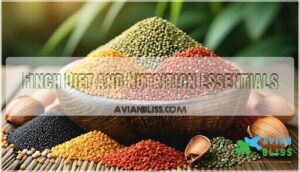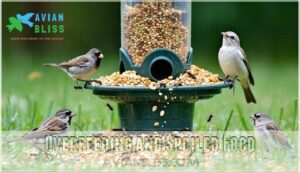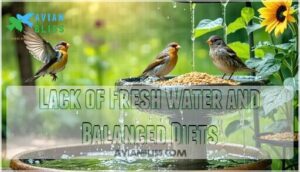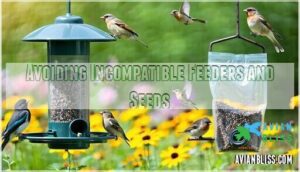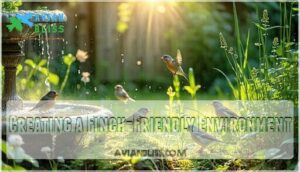This site is supported by our readers. We may earn a commission, at no cost to you, if you purchase through links.
 Finches thrive on seeds high in oils, like Nyjer® (also called thistle) and sunflower kernels, since these fit perfectly into their small beaks.
Finches thrive on seeds high in oils, like Nyjer® (also called thistle) and sunflower kernels, since these fit perfectly into their small beaks.
Blend these with millet or canary seed for a balanced diet. A mesh sock or tube feeder designed for finches works best to hold tiny seeds securely.
Don’t forget to provide fresh water; finches need it for drinking and bathing. To attract them, try planting native grasses and flowers that produce seed heads.
Avoid offering stale food—it can turn finicky finches away fast. Curious about top-rated seed blends or feeders? There’s a lot more to discover!
Table Of Contents
- Key Takeaways
- Finch Diet and Nutrition Essentials
- Attracting Finches to Your Backyard
- Top 14 Best Bird Food for Finches
- 1. Wagner Nyjer Seed Wild Bird Food 5 Pound Bag
- 2. Kaytee Finch Wild Bird Food
- 3. Pennington Wild Finch Bird Seed Blend
- 4. Happy Wings Nyjer Thistle Bird Seed
- 5. Kaytee Canary Finch Food 2 lb
- 6. Wild Harvest Canary Finch Seed Mix
- 7. Kaytee Finch Food Waste Free Blend
- 8. Wild Harvest Small Bird Food Blend
- 9. Happy Wings Finch Blend Bird Food
- 10. Wagner’s Wild Bird Food Variety Blend
- 11. Droll Yankees Finch Flocker Bird Feeder
- 12. Droll Yankees Classic Bird Feeder
- 13. Aspects Large Seed Tube Feeder Brushed Nickel
- 14. Aspects Seed Tube Feeder Brushed Nickel
- Finch Feeding Guidelines and Mistakes
- Creating a Finch-Friendly Environment
- Frequently Asked Questions (FAQs)
- Do finches prefer Nyjer or thistle seed?
- What is finch’s favorite food?
- What is the best bird seed to attract goldfinches?
- Why are finches not eating nyjer seed?
- What is the best bird food for finches?
- What do pet finches eat?
- What do finches eat besides seeds?
- How do you feed a finch?
- What do finches eat in winter?
- What fruits can you eat if you have a finch?
- Conclusion
Key Takeaways
- Keep finch feeders stocked with Nyjer seed and sunflower kernels for their high oil content and energy boost.
- Store seeds in airtight containers and replace stale ones every 3–4 weeks to prevent spoilage.
- Provide fresh water daily for hydration and place feeders near native plants like thistle and sunflowers.
- Choose specialized feeders, like tube or sock feeders, to accommodate small beaks and minimize waste.
Finch Diet and Nutrition Essentials
Finches thrive on a diet rich in seeds, especially high-oil options like Nyjer and sunflower kernels, which provide essential energy.
Finches flourish with high-oil seeds like Nyjer and sunflower kernels, fueling their vibrant energy and colorful presence year-round.
To keep them healthy, you’ll also need to make certain access to fresh water and a balanced mix of nutrients year-round.
Seed-Based Diets
Finches thrive on seed-based diets packed with nutrition and energy. Essentials include Nyjer Seed, Sunflower Chips, and Finch Blends. Knowing their dietary preferences helps attract vibrant visitors to your yard.
- Choose seed mixes featuring Nyjer and sunflower chips.
- Store seeds in airtight containers for freshness.
- Remove hulls regularly to prevent waste.
- Use finch-specific seed blends.
- Rotate seeds to maintain interest.
Nyjer Seed and Sunflower Kernels
Nyjer seed and sunflower kernels are the dynamic duo of finch feeding.
Nyjer seed and sunflower kernels deliver essential energy and nutrition, making them the ultimate powerhouse pair for thriving, vibrant finches.
Nyjer’s freshness matters—it spoils fast, so airtight seed storage is key. Sunflower seeds pack kernel nutrition that supports a finch diet year-round.
These seeds work well in finch seed blends and fit various feeder types. Check the table below for a quick comparison!
| Feature | Nyjer Seed | Sunflower Kernels |
|---|---|---|
| Oil Content | High | Moderate |
| Spoilage Risk | High | Low |
| Preferred Blends | Finch seed blends | Mixed seed blends |
| Feeder Types | Sock, tube | Versatile |
| Storage Needs | Airtight | Moderate |
The oil content and spoilage risk of these seeds are important considerations for finch owners. Understanding the preferred blends and feeder types can help create an ideal feeding environment.
Fresh Water and Balanced Diets
Keep finches healthy with a fresh water source for proper hydration and electrolyte balance.
Clean water daily to prevent illness.
Natural food sources and a finch food mix with balanced finch nutrition needs work best.
Consider organic farming practices for a healthier ecosystem.
Enhance their diet with these essentials:
- Seed hydration for moisture
- Grit supplementation for digestion
- Finch diet options with varied ingredients
- Clean water hygiene routinely maintained to support proper hydration and overall well-being.
Attracting Finches to Your Backyard
To attract finches, provide feeders stocked with high-oil seeds like Nyjer and sunflower kernels, which suit their small beaks.
Adding fresh water and planting seed-producing plants creates an inviting environment they’ll frequent year-round, with high-oil seeds being a key attraction.
Finch-Friendly Feeders and Seeds
To attract finches, use specialized feeder types like tube feeders, finch stations, or feeder socks that cater to their small beaks.
Offer a seed variety such as Nyjer, sunflower kernels, or a quality finch food mix. Keep feeders clean to prevent disease, and use squirrel-proofing for protection.
Consider exploring different finch feeder models for maximum attraction. Proper placement guarantees they feel safe while accessing their best finch seed options with the right feeder types.
Suet Cakes and Fresh Fruits
Suet cakes and fresh fruits are fantastic additions to finch feeding routines.
Opt for suet ingredients like seeds and nuts for finch nutrition.
Seasonal suet works well, especially in winter.
Include fruit options like oranges, apples, or berries to meet finch feeding preferences.
High calorie suet provides essential energy, particularly during colder months.
Prepare small portions to avoid waste, and monitor feeding frequency to match finch feeding habits, ensuring finch nutrition and providing high calorie suet.
Top 14 Best Bird Food for Finches
Finding the best bird food for finches guarantees they get the nutrition they need while keeping them healthy and active.
This list of 14 top options highlights seeds and blends that cater to their preferences, making your feeder a favorite spot.
1. Wagner Nyjer Seed Wild Bird Food 5 Pound Bag
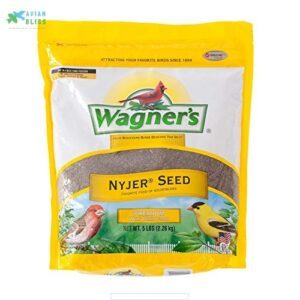
If you’re looking for a reliable choice to attract finches, Wagner’s Nyjer Seed Wild Bird Food delivers.
Packed with high fat and protein, it provides the energy finches need, especially during colder months.
Its fine quality and extra-clean seeds minimize mess and waste, while the reclosable bag guarantees freshness.
Perfect for finch-specific feeders, it’s designed to discourage larger birds, letting finches feast comfortably.
With approximately 150,000 seeds per pound, this blend guarantees frequent feeder visits and long-term enjoyment for backyard birdwatchers.
Best For: Backyard bird enthusiasts who want to attract finches and small songbirds with minimal mess and waste.
- High fat and protein content for finches’ energy needs.
- Extra-clean seeds reduce mess and waste.
- Reclosable bag ensures freshness and easy storage.
- Requires finch-specific feeders to prevent seed loss.
- May attract starlings during extreme weather.
- Needs regular cleaning under feeders to manage seed mess.
2. Kaytee Finch Wild Bird Food
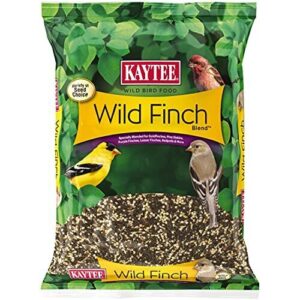
Kaytee Finch Wild Bird Food is a top choice for finch enthusiasts.
Packed with Nyjer seed, sunflower chips, and millet, it offers high energy and nutrition for small-beaked birds.
The blend caters to finches’ preferences while avoiding fillers, ensuring no wasted seeds.
Its high oil content supports year-round feeding and sustains finches during colder months.
Keep the mix fresh, as finches prefer food without spoilage.
This carefully crafted formula attracts a variety of finch species, perfect for creating a lively backyard sanctuary with high energy and small-beaked birds.
Best For: Bird enthusiasts aiming to attract a variety of finches and small-beaked birds to their backyard feeders.
- High-energy blend with Nyjer seed and sunflower chips.
- No fillers for less waste and better nutrition.
- Suitable for year-round feeding in all seasons.
- Some birds may not prefer the millet included in the mix.
- Feeder openings may not accommodate larger birds.
- Requires regular cleaning and fresh refills to maintain appeal.
3. Pennington Wild Finch Bird Seed Blend
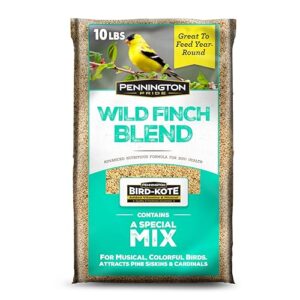
Pennington Wild Finch Bird Seed Blend is a solid choice for attracting finches to your yard.
Packed with white proso millet, sunflower chips, and thistle seed, it offers high-energy nutrition ideal for finches’ active lifestyles.
This blend supports their health with added vitamins and minerals through Bird-Kote technology.
Compatible with various feeders, the 10-lb bag is versatile for year-round use.
It also works for attracting other birds like cardinals and siskins, and by keeping your feeder full, finches will keep coming back with year-round use and enjoy the active lifestyles.
Best For: Backyard bird enthusiasts looking to attract finches and other songbirds with a nutritionally enriched seed blend.
- Nutritionally enriched with Bird-Kote technology for bird health.
- Attracts a variety of birds, including finches, cardinals, and siskins.
- Compatible with multiple feeder types for versatile use.
- Packaging is thin and prone to damage during shipping.
- Contains millet shells, which may create mess around feeders.
- Ingredient consistency has varied in recent batches.
4. Happy Wings Nyjer Thistle Bird Seed
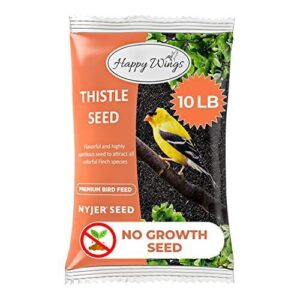
Happy Wings Nyjer Thistle Bird Seed is a powerhouse choice for attracting finches.
Packed with 30% fat and 16% protein, it offers the energy and nutrition finches crave year-round. Each pound contains approximately 150,000 seeds, ensuring long use without waste.
The no-growth formula keeps your yard tidy while remaining rich in essential nutrients. Processed in a USDA-approved facility, it meets top safety standards.
Perfect for tube or sock feeders, this seed keeps your backyard bustling with goldfinches and other beautiful songbirds.
Best For: Wild bird enthusiasts looking to attract finches and songbirds while keeping their yards clean.
- High in protein and fat for excellent bird nutrition.
- No-growth formula prevents unwanted yard mess.
- Suitable for tube and sock feeders, ideal for year-round feeding.
- Not suitable for human consumption.
- Requires specific feeders for optimal use.
- May need frequent refilling due to small seed size.
5. Kaytee Canary Finch Food 2 lb
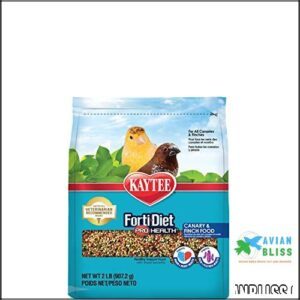
A well-stocked feeder can attract finches like magnets, and this 2-pound bag of Kaytee Canary Finch Food fits the bill.
Packed with canary grass seed, millet, flaxseed, and sunflower seed, it delivers balanced nutrition for vibrant plumage and strong immunity.
Probiotics and Omega 3s boost digestion and brain health, while antioxidants enhance your bird’s overall look.
Designed for easy consumption, it’s suitable for wild and pet finches alike, with freshness preserved naturally, ensuring every bite is as enticing as the first.
Best For: Bird enthusiasts and pet owners looking to provide balanced, nutritious food for canaries and finches.
- Includes artificial colors and preservatives which some may prefer to avoid.
- Occasional concerns about affordability due to third-party shipping costs.
- Birds may show a higher preference for colored bits over natural seeds.
- Packed with Omega 3s, vitamins, and antioxidants for vibrant plumage and strong immunity.
- Suitable for both wild and pet finches, with easy-to-eat seed blend.
- Naturally preserved for long-lasting freshness.
6. Wild Harvest Canary Finch Seed Mix

Wild Harvest Canary Finch Seed Mix offers a balanced diet formulated for finches and canaries.
With a blend of millet, canary grass seed, and flax seed, it mirrors natural foraging, encouraging healthy eating habits.
Enriched with vitamins, minerals, and Omega-3 fatty acids, it supports shiny feathers and overall vitality.
The mix is ideal for small birds, delivering essential nutrients while being easy to serve in feeders, making it a great choice for backyard bird enthusiasts seeking simplicity and nutrition.
Best For: Backyard bird enthusiasts and pet owners caring for finches, canaries, or other small birds.
- Enriched with vitamins, minerals, and Omega-3 for shiny feathers and overall health.
- Encourages natural foraging behaviors with a blend that mirrors birds’ natural diet.
- Easy to serve in feeders and suitable for mixing with other seeds for variety.
- Contains artificial colorants and preservatives.
- May be considered expensive by some customers.
- Not ideal for households seeking an organic-only bird seed option.
7. Kaytee Finch Food Waste Free Blend
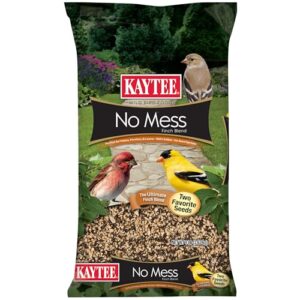
Kaytee Finch Food Waste Free Blend is a superior choice for backyard birders seeking mess-free feeding.
With hulled sunflower seeds, shelled peanuts, and added calcium, it provides balanced nutrition for finches of all life stages.
The 100% edible blend leaves no messy shells, ensuring easy cleanup and preventing unwanted plant growth.
Its waste-free formula is ideal for attracting vibrant finches year-round.
Packaged in bulk 6-packs of 8 lb bags, you’ll have plenty to keep your feathered visitors happy and well-fed.
Best For: Backyard birders looking for a mess-free, nutritionally balanced seed blend to attract finches year-round.
- 100% consumable, waste-free formula for easy cleanup.
- Includes hulled sunflower seeds, shelled peanuts, and added calcium for balanced nutrition.
- Bulk packaging provides convenience and long-term use.
- Outdoor use only, limiting versatility.
- May not attract bird species other than finches.
- Bulk 6-pack might be excessive for casual feeders.
8. Wild Harvest Small Bird Food Blend

Wild Harvest Small Bird Food Blend caters to finches, offering a balanced mix of seeds like canary grass, red and white millets, and wholesome grains.
Enriched with essential vitamins and minerals, this blend bolsters small birds’ health.
It’s easy to use—just fill the feeder daily with fresh seeds, ensuring the dish is clean to maintain hygiene.
While finches love its variety, some filler seeds might be left uneaten.
Best For: Small bird owners who want a nutrient-rich, balanced seed mix for finches, canaries, and parakeets.
- Enriched with essential vitamins and minerals for bird health.
- Includes a balanced variety of seeds and wholesome grains.
- Easy to use and maintain with daily feeding instructions.
- Some filler seeds may go uneaten by birds.
- Not ideal for all bird species, such as diamond doves.
- Contains artificial color additives that may raise concerns for some pet owners.
9. Happy Wings Finch Blend Bird Food

The Happy Wings Finch Blend Bird Food is a superior choice for attracting vibrant finches to your yard.
Combining thistle seed and sunflower kernels, it provides high oil and protein content, guaranteeing excellent nutrition and energy.
This blend’s non-germinating seeds keep your backyard clean, saving you from unwanted plant growth.
Finches, especially goldfinches, love it and consume it quickly, according to customers.
For ideal finch health, consider organic seed options.
However, guarantee your feeder accommodates the seed size for best results.
This blend is perfect for finch enthusiasts seeking convenience and effectiveness.
Best For: Bird enthusiasts looking to attract vibrant finches like goldfinches and house finches while keeping their backyard clean.
- Seed size may not fit all finch feeders.
- High consumption rate may lead to frequent repurchasing.
- Considered pricey by some customers.
- High in oil and protein for optimal bird nutrition.
- Non-germinating seeds prevent backyard mess and plant growth.
- Widely loved by finches, ensuring effective attraction.
10. Wagner’s Wild Bird Food Variety Blend
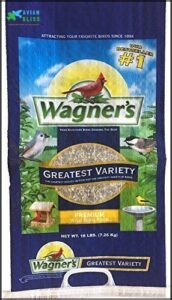
Offering a blend of 12 premium ingredients, Wagner’s Wild Bird Food Variety Blend is a versatile option that finches adore.
Packed with black oil sunflower seeds, Nyjer, and safflower, it attracts an impressive range of finches alongside other songbirds.
Its diverse mix guarantees high energy and nutrition, making it suitable for tube, hopper, or platform feeders.
While its non-waterproof bag requires careful storage, transferring it to a sealed container keeps it fresh and this mix keeps feeders bustling and your backyard teeming with life.
Best For: Bird enthusiasts looking to attract a diverse range of songbirds and ground feeders to their backyard.
- High-quality, 12-ingredient blend attracts a variety of bird species.
- Suitable for multiple feeder types, including tube, hopper, and platform feeders.
- Made with fresh, USA-sourced ingredients and satisfaction guaranteed.
- Non-waterproof packaging requires storage in a sealed container.
- Contains raisins, which can be toxic to pets if ingested.
- Some ingredients may attract nuisance birds and squirrels.
11. Droll Yankees Finch Flocker Bird Feeder

The Droll Yankees Finch Flocker Bird Feeder is a perfect choice for finch enthusiasts.
Its durable, UV-stabilized polycarbonate tube resists yellowing, while vibrant yellow accents naturally attract goldfinches.
Featuring offset feeding ports and an angled base, it guarantees easy access for birds, preventing seed waste.
The chew-proof stainless steel wire hanger and zinc diecast metal parts add longevity.
Available in various sizes, it’s ideal for different yard spaces.
This feeder’s thoughtful design makes it an attractive, reliable option for brightening your backyard with active finches.
Best For: Finch enthusiasts and backyard bird watchers who want a durable, attractive feeder for goldfinches and similar small birds.
- Durable materials like stainless steel and UV-stabilized polycarbonate.
- Offset feeding ports and angled base prevent seed waste.
- Available in multiple sizes to fit various spaces.
- Polycarbonate tube may be vulnerable to damage.
- Feed holes can be difficult for birds to locate initially.
- Bottom removal for cleaning requires significant force.
12. Droll Yankees Classic Bird Feeder
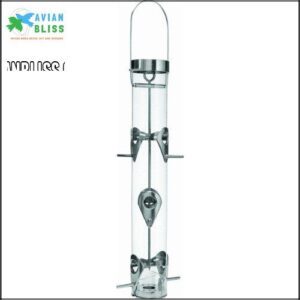
The Droll Yankees Classic Bird Feeder is a solid choice for finch enthusiasts.
With a UV-stabilized polycarbonate tube and durable metal components, it’s built to last and even resisted bear attacks.
Its six feeding ports cater to smaller birds like finches and chickadees, ensuring easy access to seeds like Nyjer and sunflower kernels.
The Ring Pull Advantage makes cleaning quick and hassle-free, helping keep your backyard birds healthy, and it’s a reliable way to create a finch-friendly feeding space, perfect for long-term use.
Best For: Finch enthusiasts and backyard bird watchers looking for a durable, easy-to-clean bird feeder that attracts small songbirds.
- Durable construction with UV-stabilized polycarbonate and metal components.
- Six feeding ports designed for smaller birds like finches and chickadees.
- Ring Pull Advantage allows for easy cleaning without tools.
- Limited access for larger birds such as cardinals.
- Higher price point compared to other feeders.
- Assembly may be challenging due to metal bar alignment.
13. Aspects Large Seed Tube Feeder Brushed Nickel

The Aspects Large Seed Tube Feeder in brushed nickel is both stylish and functional, perfect for your backyard.
With 10 feeding stations and a built-in seed deflector, it guarantees that finches can access every last seed.
Its die-cast metal and UV-stabilized polycarbonate construction make it durable and weather-resistant.
The quick-clean removable base simplifies maintenance, while hex-shaped perches keep birds comfortable.
This feeder holds 1.75 quarts and accommodates various seed types, making it versatile and an excellent investment backed by a lifetime guarantee.
Best For: Bird enthusiasts looking for a durable, stylish feeder that attracts various bird species and simplifies maintenance.
- Higher price point compared to alternatives.
- Rubber perch covers may be damaged by squirrels.
- Spring-loaded tabs for base removal can break.
- Durable die-cast metal and UV-stabilized construction.
- Quick-clean removable base for easy maintenance.
- Accommodates various seed types for versatility.
14. Aspects Seed Tube Feeder Brushed Nickel

This Aspects Seed Tube Feeder in Brushed Nickel is a durable and versatile choice that’s built to last.
With its 1.25-quart capacity and 4 feeding ports, it attracts various finches like goldfinches, siskins, and purple finches.
The quick-clean removable base makes maintenance hassle-free, while the UV-stabilized polycarbonate tube prevents wear from sunlight.
Its built-in seed deflector guarantees birds reach every seed, reducing waste, and the sturdy metal components resist weather and damage, offering long-term value.
Perfect for sunflower seeds or specialty blends, it’s finch-friendly and reliable.
Best For: Bird enthusiasts seeking a durable, easy-to-maintain feeder that attracts a variety of finches and other small bird species.
- Quick-clean removable base for easy maintenance.
- Durable, weather-resistant construction with long-lasting materials.
- Attracts a wide range of bird species with its versatile design.
- May be expensive compared to other feeders.
- Accessories like seed tray and dome may not effectively protect seed from rain.
- Grackles can still raid the feeder despite perch-friendly design.
Finch Feeding Guidelines and Mistakes
Feeding finches might seem simple, but it’s easy to make common mistakes like overfilling feeders or offering stale seeds.
Understanding proper feeding guidelines helps you attract healthy finches while avoiding issues that could harm their well-being.
Overfeeding and Spoiled Food
Overfeeding finches can lead to spoiled food and wasted seed, attracting pests and increasing mold risks.
Rotate seeds regularly to prevent stale seeds and odors. Feeder hygiene is essential—clean feeders frequently to avoid health issues.
Proper bird seed storage reduces spoilage. To further enhance your feeding setup, consider feeder placement strategies for attracting more finches.
Follow these finch feeding tips for effective waste reduction and healthier, happier birds visiting your yard, ensuring a better feeding setup with healthier birds.
Lack of Fresh Water and Balanced Diets
Fresh water is essential for finch nutrition, especially during molting or winter hydration.
Stagnant water deters birds, so guarantee water freshness by changing it daily.
A balanced bird diet isn’t just seeds—mix finch food types for diet variety.
Supplementing seeds with fruits or plants supports their health.
Follow this finch feeding guide to provide proper nutrition year-round.
Avoiding Incompatible Feeders and Seeds
Choosing the right finch feeders and seeds prevents common mistakes.
Dirty feeders or overcrowded ports can push finches away.
Avoid seed spoilage by replacing Nyjer every few weeks.
Hull buildup under feeders isn’t just messy—it blocks plant growth.
Stick to quality finch seed mixes that exclude fillers like millet.
Use small feeder sizes with easy-to-clean materials for best results, ensuring a clean and quality environment.
Creating a Finch-Friendly Environment
Creating a finch-friendly environment starts with planting seed-rich grasses and weedy plants that mimic their natural habitat.
Add features like running water and soft nesting materials to guarantee finches stay active and healthy year-round, which includes providing them with a suitable environment to thrive in their natural habitat with weedy plants.
Planting Grassy and Weedy Species
Encourage finches by planting birdfriendly gardens with native grasses and seed-producing plants like thistle, sunflowers, and milkweed.
These support finch feeding habits and provide natural food sources.
Cottonwood fluff and Joe Pye weed add nesting appeal.
Look at birdfriendly plants perfect for finches:
| Plant | Benefit | Attracts |
|---|---|---|
| Thistle plants | Seeds, nesting material | Goldfinches |
| Milkweed | Fluff for nesting | Various finches |
| Sunflowers | Seeds | American goldfinches |
These plants, including thistle and milkweed, are essential for supporting the local finch population by offering them the necessary resources for survival.
Providing Running Water and Nesting Materials
Adding a water source is key to attracting finch species.
Running water, like a birdbath fountain, caters to seasonal water needs, keeping your yard lively year-round.
Consider adding a birdbath fountain option to enhance your yard.
Encourage nesting by scattering soft materials like thistle fluff and cottonwood.
These nesting material types, alongside birdfriendly plants for finches, create a thriving finch habitat.
A birdfriendly backyard promotes safety and belonging for finches.
Using Finch Stations and Feeder Socks
Finch stations and feeder socks cater to finch feeding preferences by accommodating their small beaks and specific behaviors.
Choose durable sock materials and finch feeder designs with adequate seed capacity for group feeding. Make certain proper feeder placement, away from weather exposure, and clean frequently to prevent mold.
You can find suitable finch feeder socks online.
Seed tubes and weather protection extend usability, giving you a perfect setup for finch feeding supplies.
Frequently Asked Questions (FAQs)
Do finches prefer Nyjer or thistle seed?
Imagine a buffet where finches choose thistle, a beloved delicacy in the form of Nyjer seeds.
Packed with energy-rich oil, Nyjer is their favorite.
You’ll find these tiny seeds irresistible to your colorful feathered visitors.
What is finch’s favorite food?
Nyjer seed, also called thistle, is a finch favorite due to its high oil content and energy boost.
Sunflower chips also rank high, offering easy feeding and nutritious value, especially for smaller finch species.
What is the best bird seed to attract goldfinches?
Nyjer seeds, also called thistle, are the best for attracting goldfinches.
Their high oil content offers energy, and the small size suits their beaks perfectly.
Keep them fresh in airtight containers, replacing every 3-4 weeks to maintain their quality and energy content.
Why are finches not eating nyjer seed?
Your finches mightn’t eat nyjer seed if it’s stale.
Nyjer spoils quickly, especially in humid conditions.
Keep it fresh by storing it airtight and replacing it every 3–4 weeks for better results.
What is the best bird food for finches?
The best food for finches includes Nyjer seeds, Sunflower seeds, and Finch blends with thistle or sunflower chips.
These options provide essential oils and nutrients, supporting their energy needs while complementing their small beaks and feeding habits with thistle.
What do pet finches eat?
Over 30% of pet finches thrive on seeds like millet, Nyjer, and sunflower, but don’t stop there.
Fresh veggies, fruits, and egg-based supplements add nutrients.
Rotate options to keep them happy and healthy.
What do finches eat besides seeds?
Beyond seeds, finches enjoy fresh fruits like apples or berries and leafy greens such as spinach or dandelion.
Small insects, like aphids, add protein, especially during breeding seasons when energy demands increase.
How do you feed a finch?
Think of feeding finches like setting up a tiny buffet.
Offer Nyjer or sunflower seeds in specialized feeders like socks or tubes.
Clean regularly, keep seeds fresh, and provide nearby water for hydration and bathing.
What do finches eat in winter?
In winter, finches rely on high-energy seeds like Nyjer, black oil sunflower, and thistle.
Their smaller beaks are perfect for cracking these seeds, giving them essential nutrients and energy to stay active in colder months.
What fruits can you eat if you have a finch?
A well-rounded treat for finches includes diced apples (seed-free), pears, and bananas.
Add berries like blueberries or raspberries occasionally.
Always wash fruit, remove seeds, and serve in moderation for healthy, happy feathered friends.
Conclusion
Imagine vibrant finches flocking to your yard, their tiny beaks savoring the best bird food for finches.
By offering nutrient-rich options like Nyjer seed, sunflower kernels, and balanced blends, paired with proper feeders and fresh water, you create an irresistible sanctuary.
Supporting their needs with native plants and thoughtful feeding practices guarantees their comfort and health.
Avoid spoiled food or neglecting water, and you’ll see these cheerful birds thrive, bringing beauty and life to your outdoor space, with proper feeders.

